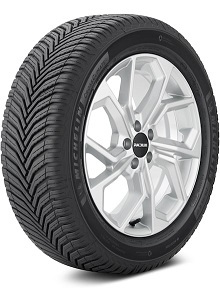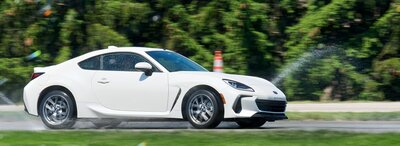Tire Test: Grand Touring All Season Ride & Drive Report
 |
SEE ALSO: Test Video
SEE ALSO: Road Handling Data
TireRack reported the result of their road tests of Grand Touring All-Season tires represent the pinnacle of on-road design for the daily driver. They strive to offer a high-level blend of comfort, handling, traction and tread life, which is no small feat. In this report, we test one of the newest entries to the category, the Bridgestone WeatherPeak, against two popular benchmark performers.
ROAD MANNERS & DRY/WET TRACK(COMBINED SUBJECTIVE RATING) (Higher number is better)
1- Bridgestone WeatherPeak (7.13)
2- Continental PureContact LS (7.20)
3- Michelin CrossClimate2 (7.38)
 Testing Grand Touring All-Season Tires |
Tires Tested
Bridgestone WeatherPeak (Grand Touring All-Season, 225/45R17 91V)- What We Liked: Great on-road manners and steering.
- What We'd Improve: It could use more composure when pushed.
- Conclusion: An impressive package that's ready to compete with the best.
- What We Liked: Athletic handling and traction.
- What We'd Improve: Add some more on-road refinement.
- Conclusion: It's still right up there with the top performers.
- What We Liked: Its precise steering and well-damped ride.
- What We'd Improve: Tune out a little road noise on smooth pavement.
- Conclusion: Does everything well with no real compromises.
Vehicles Used
2022 Subaru BRZ LimitedGrand Touring All-Season tires represent the pinnacle of on-road design for the daily driver. They strive to offer a high-level blend of comfort, handling, traction and tread life, which is no small feat. With consumer expectations growing by the year, along with vehicle performance and capabilities, the tire's role in satisfying consumers has become even more important. Good light snow traction for mild winter climates has become a trend in the category, with manufacturers designing tires that meet the industry's severe snow service requirements. However, it's not enough to offer the enhanced winter performance at the expense of expected comfort, dry and wet traction, or tread life. With such a high bar, we've seen engineers leverage cutting-edge technologies to create the some of the most advanced Grand Touring All-Season tires to date.
One of the latest entries into this space is the Bridgestone WeatherPeak. As the name might suggest, it's designed to offer increased levels of light snow traction while maintaining the standards of luxury and summer performance requisite of its touring tire category. The innovative all-season compound is molded into a carefully executed pattern that's engineered to enhance traction in all conditions while minimizing airborne noise. Utilizing advanced technologies like snow vices and evolving- and full-depth sipes, the WeatherPeak also offers the traction needed in inclement weather for year-round confidence.
To find out how the Bridgestone WeatherPeak compares to its competition, our team tested it against two well-known and popular Grand Touring All-Season tires. The Michelin CrossClimate2 is a strong, well-rounded performer and is no stranger to our testing. It has established itself as one of the largest targets in the segment, and like the WeatherPeak, offers strong winter performance with the 3PMSF branding. The Continental PureContact LS is another strong benchmark that has satisfied drivers in the dry, wet and snow. While it does not carry the 3PMSF branding, its history of testing well in the snow should serve as a reminder that the rating is not a prerequisite for capable, all-season winter performance. To put these three strong competitors to the test, our evaluation used 2022 Subaru BRZ Limited test vehicles fitted with new, full tread depth 225/45R17 tires mounted on 17x8.0 wheels.
What We Learned on the Road
Our 6.0-mile loop of expressway, state highway and county roads provides a great variety of road conditions that include city and highway speeds, smooth and coarse concrete, as well as new and patched asphalt. This route allows our team to experience noise comfort, ride quality and everyday handling, just as you would during your drive to school or work.
A touring tire should be built to soak up the miles, and as Grand Touring All-Season serves as the highest level of luxury in our lineup, these three tires needed to impress on the street if they aim to fully satisfy drivers. The Bridgestone WeatherPeak proved right away it was up to that task with refined manners throughout the route. Its somewhat blocky pattern managed to mitigate road noise to the best levels in the test. Tones were blended into even and consistent sounds that faded into the background. The Bridgestone's well-metered steering also found high praise from our drivers thanks to its precise and remarkably smooth response throughout the range of inputs found on the road. The ride was firm, but well-damped and didn't find itself out of place, even in this group. The CrossClimate2 managed to clinch the best ride quality of the group thanks to its expertly-damped impacts that made the taut ride feel well-controlled and comfortable. The Michelin's steering was equally well-executed with a high level of precision that allowed the driver to dial in the exact amounts of steering through the corners with minimal correction. The tire had a satisfying ramp-up of response with significant wheel inputs that at times were reminiscent of a performance tire. The distinct tread pattern of the CrossClimate2 is a commendable achievement but most likely did generate some of the lower-pitched growl heard on smooth pavement. Regardless, the Michelin's subjective noise comfort was within striking distance of the other two, less aggressive competitors in the test, which is an impressive feat, and should allow it to satisfy most drivers in any environment. The PureContact LS also had a well-balanced performance around our road loop with good noise comfort that blended some slight multi-tone tread noise into the background on all but the smoothest surfaces. Impacts from the Continental were compliant, but at times, felt a little uncontrolled compared to the other well-damped tires in the test. Steering also seemed a little overly stiff on-center which is usually something our drivers appreciate, but it required a disproportionate amount of steering effort to get the tire to respond, which then could overwhelm the input.
What We Learned on the Test Track
Our 1/3-mile per lap test track course includes 90-degree street corners, a five-cone slalom and simulated expressway ramps. Run in both dry and wet conditions, the test track allows our team to experience the traction, responsiveness, handling and drivability normally only encountered during abrupt emergency avoidance maneuvers or competition events.
Wet grip can be a direct trade-off with snow traction, so an all-season tire's task of not only combining acceptable amounts of the two but excelling in the wet can be a real challenge for designers. The PureContact LS managed to not only satisfy, but impress our team with the highest lateral traction levels around the skidpad and the shortest braking distance from fifty miles per hour. With the competition right on its heels, objectively and subjectively, the Continental was able to turn the fastest wet laps of the test, no doubt in part to its slight traction advantage. Our team found it capable through the turns but thought the tire's steering was a little vague, with a tendency to understeer through most corners. The CrossClimate2 matched the PureContact LS subjectively but found itself at a slight disadvantage in measured traction on our track. The steering from the Michelin, however, was sharp and precise, giving it strong front-end authority, which made it easy to place the car exactly where our drivers wanted through the turns. Braking consistency from the Michelin on the more dynamic conditions of the handling course was also appreciated by the team, which helped make it the easiest tire to drive at a consistently fast pace. The WeatherPeak generated competitive lateral traction figures along with braking distances in line with the tight test group. Putting it all together into laps was more difficult however, with lap times coming in a slight step back from the front runners in the end. The WeatherPeak struggled at times to utilize its capable grip when asked to perform multiple functions at once. It required deliberate and careful applications of steering and throttle to not overwhelm the front tires in corners or spin up the rear on the way out. It still, however, was mostly balanced and communicated its limits well, which was appreciated by our drivers, even if it did require a little more concentration to maximize.
While dry laps at 10/10th are beyond the scope of these tires, similar as in the wet, it gives our drivers the chance to push the limits of traction to see how the tires respond when they, and their drivers, are asked to go beyond their comfort zone. Our team found the PureContact LS as the subjective favorite by a very tight margin in the dry. Its higher ultimate lateral traction and bubbly, athletic feel through the turns yielded the quickest times of the test. The CrossClimate2's precise steering once again helped make it the easiest tire to drive at a consistently quick pace. The accurate turn-in and buttoned down mid-corner characteristics let our drivers meter each input to put the car exactly where they intended. The WeatherPeak found itself with a slightly more obvious traction deficit in the dry, with markedly longer stopping distances but competitive lateral traction which should satisfy consumers. With comparatively slower response rates than the other two tires, it felt closer to how most people would expect an all-season touring product to react to aggressive inputs, which isn't a bad thing. The Bridgestone was still communicative and didn't catch the driver off guard unless the line was severely overstepped. In which case, significant but easily correctable understeer would set in.
Driving in Winter Conditions
We will conduct subjective and objective tests in the snow and on the ice in the coming winter season. Stay tuned for the results once testing has been completed - sign up to be among the first to learn about new test results.
Summary
All three tires in the test perform at a high level and are great examples of what top-tier manufacturers are capable of when asked to push through design barriers. The CrossClimate2 demonstrates itself as a well-rounded package that satisfies at a high level across the board. It was never out of sight of the leader in any category or performance metric and combines everything to become more than the sum of its parts. The PureContact LS is itself an impressive package with competitive road-manners and test-leading track prowess. It could benefit from some refinement at times, but the Continental is particularly impressive when one factors in its years in the marketplace compared to the others in the group. The WeatherPeak sets a high bar for road manners in the category, which is no small feat with a tread pattern that is most likely designed with an emphasis on achieving strong light snow traction. That emphasis might have hurt it at times on the track, but it's worth noting that even the stiff competition never outclassed the Bridgestone, and its non-winter performance should satisfy drivers similar to its competition.



